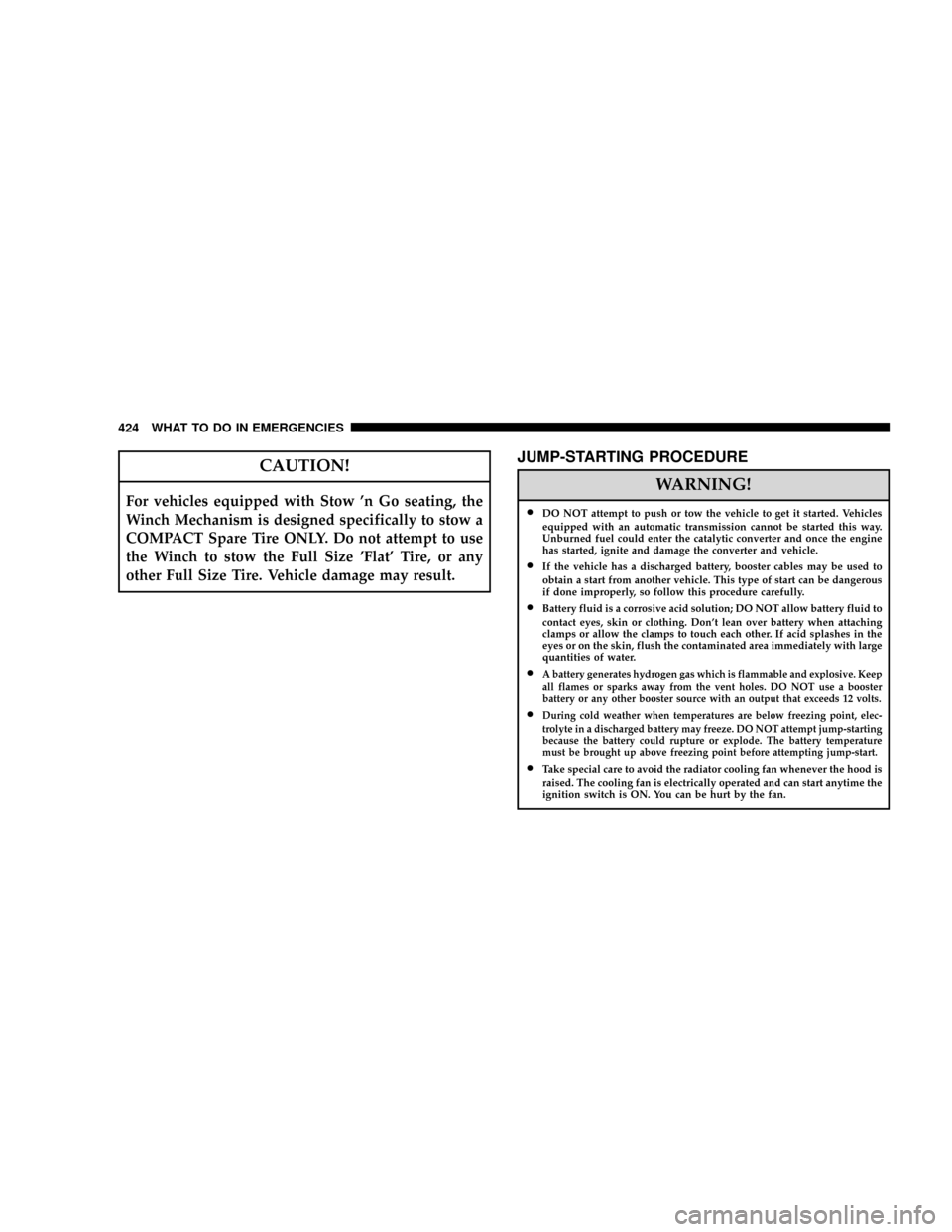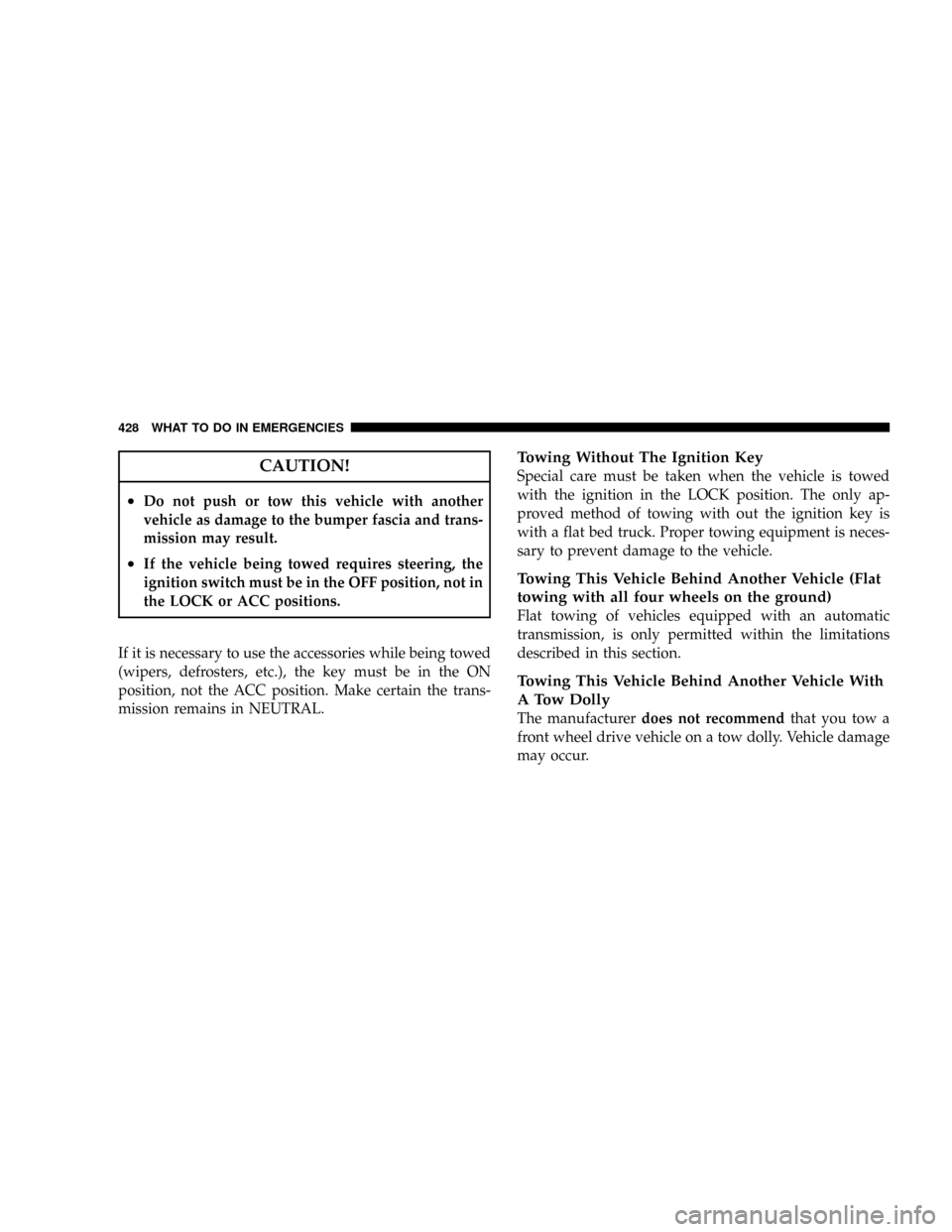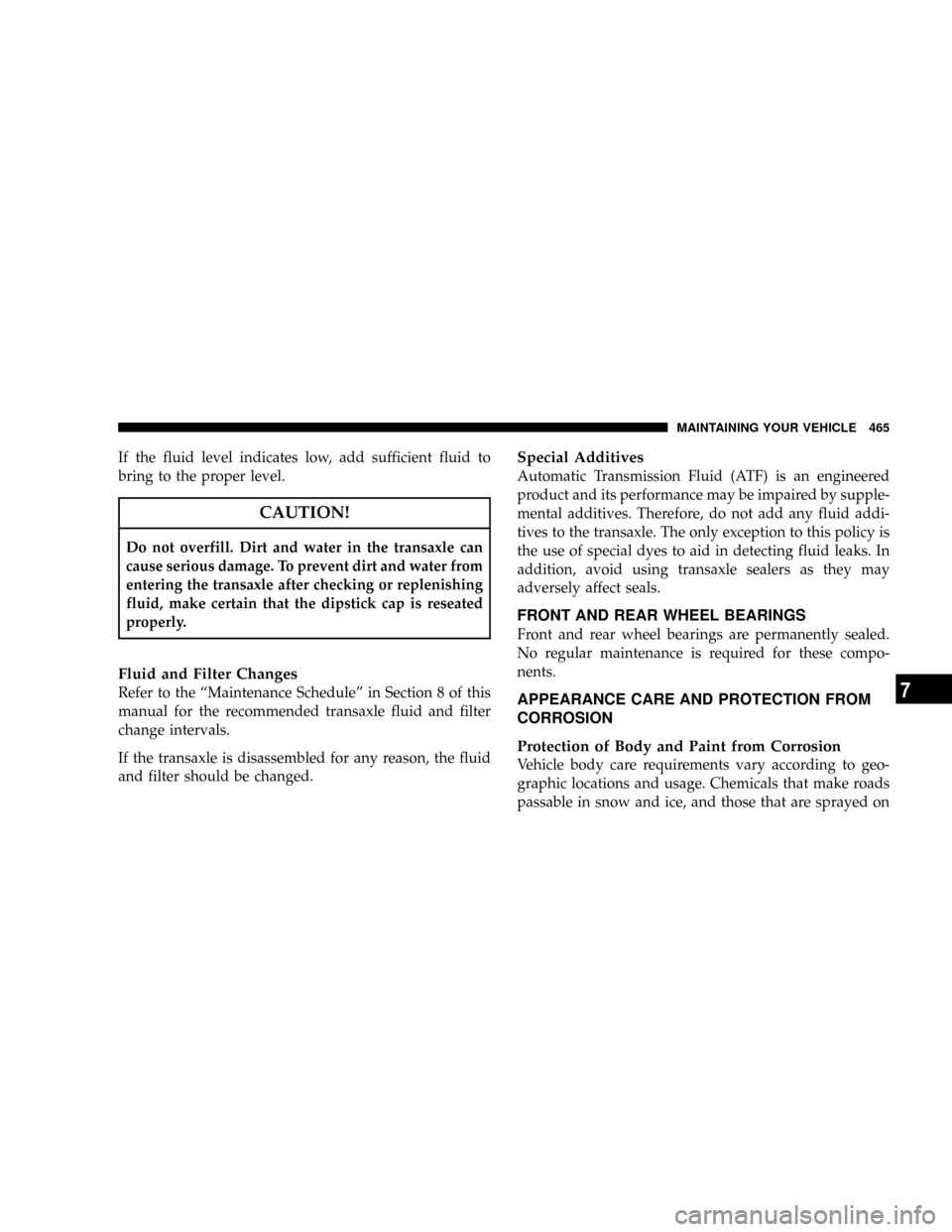Page 417 of 531
Jacking InstructionsWARNING!
Carefully follow these tire changing warnings to
help prevent personal injury or damage to your
vehicle:
²Always park on a firm, level surface as far from
the edge of the roadway as possible before raising
the vehicle.
²Block the wheel diagonally opposite the wheel to
be raised.
²Set the parking brake firmly and set an automatic
transmission in park; a manual transmission in
reverse.
Jack Warning Label
WHAT TO DO IN EMERGENCIES 415
6
Page 426 of 531

CAUTION!
For vehicles equipped with Stow 'n Go seating, the
Winch Mechanism is designed specifically to stow a
COMPACT Spare Tire ONLY. Do not attempt to use
the Winch to stow the Full Size 'Flat' Tire, or any
other Full Size Tire. Vehicle damage may result.
JUMP-STARTING PROCEDURE
WARNING!
²DO NOT attempt to push or tow the vehicle to get it started. Vehicles
equipped with an automatic transmission cannot be started this way.
Unburned fuel could enter the catalytic converter and once the engine
has started, ignite and damage the converter and vehicle.
²If the vehicle has a discharged battery, booster cables may be used to
obtain a start from another vehicle. This type of start can be dangerous
if done improperly, so follow this procedure carefully.
²Battery fluid is a corrosive acid solution; DO NOT allow battery fluid to
contact eyes, skin or clothing. Don't lean over battery when attaching
clamps or allow the clamps to touch each other. If acid splashes in the
eyes or on the skin, flush the contaminated area immediately with large
quantities of water.
²A battery generates hydrogen gas which is flammable and explosive. Keep
all flames or sparks away from the vent holes. DO NOT use a booster
battery or any other booster source with an output that exceeds 12 volts.
²During cold weather when temperatures are below freezing point, elec-
trolyte in a discharged battery may freeze. DO NOT attempt jump-starting
because the battery could rupture or explode. The battery temperature
must be brought up above freezing point before attempting jump-start.
²Take special care to avoid the radiator cooling fan whenever the hood is
raised. The cooling fan is electrically operated and can start anytime the
ignition switch is ON. You can be hurt by the fan.
424 WHAT TO DO IN EMERGENCIES
Page 427 of 531

When jump-starting, proceed as follows:
1. Wear eye protection and remove any metal jewelry
such as watch bands or bracelets that might make an
inadvertent electrical contact.
2. When a boost is provided by a battery in another
vehicle, park that vehicle within booster cable reach and
without letting the vehicles touch. Set the parking brake,
place the automatic transmission selector lever into
PARK and turn the ignition switch to the OFF position for
both vehicles.
3. Turn OFF the heater, radio and all unnecessary elec-
trical loads.
4. Connect one end of a jumper cable to the positive
terminal of the discharged battery. Connect the other end
of the same cable to the positive terminal of the booster
battery.WARNING!
DO NOT permit vehicles to touch each other as this
could establish a ground connection and personal
injury could result.
5. Connect the other cable, first to the negative terminal
of the booster battery, and then to the engine of the
vehicle with the discharged battery. Make sure there is a
good contact on the engine.
WARNING!
DO NOT connect the cable to the negative post of the
discharge battery. The resulting electrical spark could
cause the battery to explode.
WHAT TO DO IN EMERGENCIES 425
6
Page 429 of 531

CAUTION!
Racing the engine or spinning the wheels too fast
may lead to transmission overheating and failure. It
can also damage the tires. Do not spin the wheels
above 35 mph (55 km/h).
TOWING A DISABLED VEHICLE
Towing With The Ignition Key
Your vehicle may be towed under the following condi-
tions: The gear selector lever must be in NEUTRAL, the
distance to be traveled must not exceed 100 mi (160 km),
and the towing speed must not exceed 44 mph (72
km/h). Exceeding these towing limits may cause a trans-
mission geartrain failure. If the transmission is not op-
erative, or if the vehicle is to be towed more than 100 mi
(160 km), the vehicle must be towed with the front
wheels off the ground.
CAUTION!
²Do not attempt to tow this vehicle from the front
with sling type towing equipment. Damage to the
front fascia will result.
²Always use wheel lift equipment when towing
from the front. The only other approved method of
towing is with a flat bed truck.
²Do not tow the vehicle from the rear. Damage to
the rear sheet metal, liftgate and fascia will occur.
WHAT TO DO IN EMERGENCIES 427
6
Page 430 of 531

CAUTION!
²Do not push or tow this vehicle with another
vehicle as damage to the bumper fascia and trans-
mission may result.
²If the vehicle being towed requires steering, the
ignition switch must be in the OFF position, not in
the LOCK or ACC positions.
If it is necessary to use the accessories while being towed
(wipers, defrosters, etc.), the key must be in the ON
position, not the ACC position. Make certain the trans-
mission remains in NEUTRAL.
Towing Without The Ignition Key
Special care must be taken when the vehicle is towed
with the ignition in the LOCK position. The only ap-
proved method of towing with out the ignition key is
with a flat bed truck. Proper towing equipment is neces-
sary to prevent damage to the vehicle.
Towing This Vehicle Behind Another Vehicle (Flat
towing with all four wheels on the ground)
Flat towing of vehicles equipped with an automatic
transmission, is only permitted within the limitations
described in this section.
Towing This Vehicle Behind Another Vehicle With
A Tow Dolly
The manufacturerdoes not recommendthat you tow a
front wheel drive vehicle on a tow dolly. Vehicle damage
may occur.
428 WHAT TO DO IN EMERGENCIES
Page 437 of 531

ONBOARD DIAGNOSTIC SYSTEM Ð OBD II
Your vehicle is equipped with a sophisticated onboard
diagnostic system called OBD II. This system monitors
the performance of the emissions, engine, and automatic
transmission control systems. When these systems are
operating properly, your vehicle will provide excellent
performance and fuel economy, as well as engine emis-
sions well within current government regulations.
If any of these systems require service, the OBD II system
will turn on the ªMalfunction Indicator Light.º It will
also store diagnostic codes and other information to
assist your service technician in making repairs. Al-
though your vehicle will usually be drivable and not
need towing, see your authorized dealer for service as
soon as possible.CAUTION!
²Prolonged driving with the ªMalfunction Indica-
tor Lightº on could cause further damage to the
emission control system. It could also affect fuel
economy and driveability. The vehicle must be
serviced before any emissions tests can be per-
formed.
²If the ªMalfunction Indicator Lightº is flashing
while the engine is running, severe catalytic con-
verter damage and power loss will soon occur.
Immediate service is required.
MAINTAINING YOUR VEHICLE 435
7
Page 467 of 531

If the fluid level indicates low, add sufficient fluid to
bring to the proper level.
CAUTION!
Do not overfill. Dirt and water in the transaxle can
cause serious damage. To prevent dirt and water from
entering the transaxle after checking or replenishing
fluid, make certain that the dipstick cap is reseated
properly.
Fluid and Filter Changes
Refer to the ªMaintenance Scheduleº in Section 8 of this
manual for the recommended transaxle fluid and filter
change intervals.
If the transaxle is disassembled for any reason, the fluid
and filter should be changed.
Special Additives
Automatic Transmission Fluid (ATF) is an engineered
product and its performance may be impaired by supple-
mental additives. Therefore, do not add any fluid addi-
tives to the transaxle. The only exception to this policy is
the use of special dyes to aid in detecting fluid leaks. In
addition, avoid using transaxle sealers as they may
adversely affect seals.
FRONT AND REAR WHEEL BEARINGS
Front and rear wheel bearings are permanently sealed.
No regular maintenance is required for these compo-
nents.
APPEARANCE CARE AND PROTECTION FROM
CORROSION
Protection of Body and Paint from Corrosion
Vehicle body care requirements vary according to geo-
graphic locations and usage. Chemicals that make roads
passable in snow and ice, and those that are sprayed on
MAINTAINING YOUR VEHICLE 465
7
Page 479 of 531
FUSES/TIPM
CavityCartridge
FuseMini
FuseDescription
M21 Ð 20 Amp
YellowAuto Shut Down (ASD
#3)
M22 Ð 10 Amp
RedRight Horn (RT HORN
(HI/LOW)
M23 Ð 10 Amp
RedLeft Horn (LT HORN
(HI/LOW)
M24 Ð 25 Amp
NaturalRear Wiper (REAR
WIPER)
M25 Ð 20 Amp
YellowFuel Pump (FUEL PUMP),
Diesel Lift Pump (DSL
LIFT PUMP) Ð Export
Only
M26 Ð 10 Amp
RedPower Mirror Switch
(PWR MIRR SW), Driver
Window Switch (DRVR
WIND SW)FUSES/TIPM
CavityCartridge
FuseMini
FuseDescription
M27 Ð 10 Amp
RedIgnition Switch (IGN SW),
Window Module (WIN
MOD)
M28 Ð 10 Amp
RedNext Generation Control-
ler (NGC), Transmission
Feed (TRANS FEED),
J1962
M29 Ð 10 Amp
RedOccupant Classification
Module (OCM)
M30 Ð 15 Amp
BlueRear Wiper Module (RR
WIPER MOD), Power
Folding Mirror (PWR
FOLD MIR)
M31 Ð 20 Amp
YellowBack-Up Lamps (B/U
LAMPS)
MAINTAINING YOUR VEHICLE 477
7